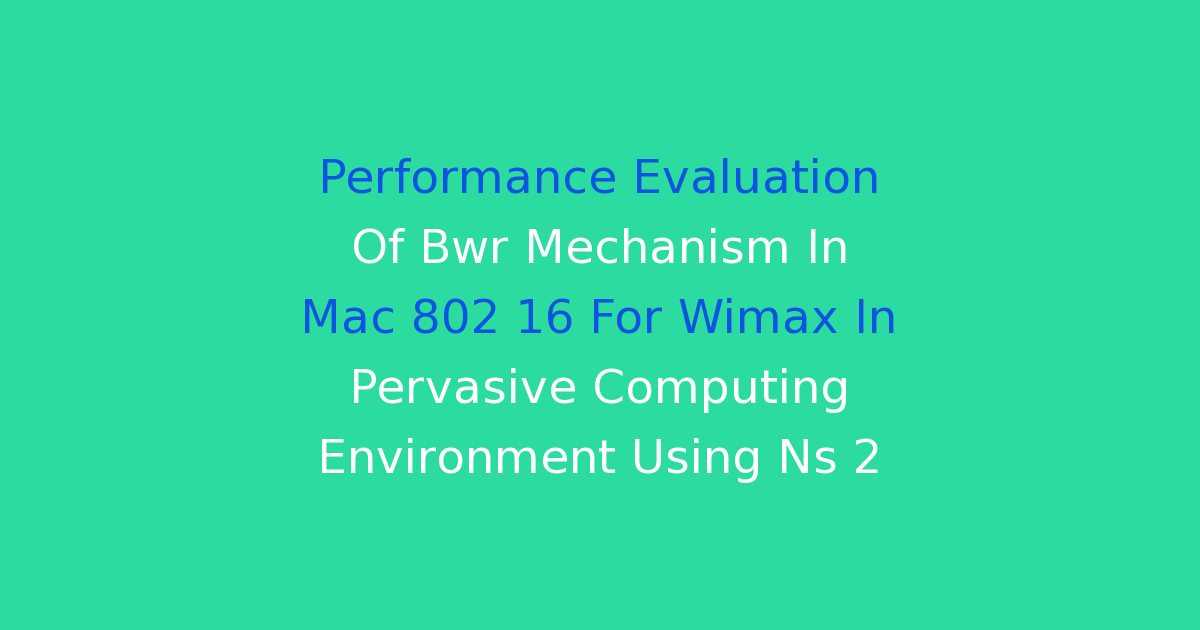Assessing the efficiency of the BWR mechanism in the MAC 802.16 protocol for WiMAX in a pervasive computing environment through performance evaluation in NS-2.
Performance Evaluation of BWR Mechanism in MAC 802.16 for WiMax in Pervasive Computing Environment using NS 2
Introduction
In today’s fast-paced world, the use of wireless communication technology has become increasingly important. With the advent of WiMax (Worldwide Interoperability for Microwave Access), there arises a need for efficient mechanisms to handle the communication between devices in a pervasive computing environment. One such mechanism is the Bandwidth Request (BWR) mechanism in Media Access Control (MAC) 802.16 for WiMax. This paper aims to evaluate the performance of the BWR mechanism in such a setting using the NS 2 simulation tool.
Problem Statement
The existing BWR mechanism in MAC 802.16 for WiMax may not be efficient enough to handle the communication demands of devices in a pervasive computing environment. There may be issues such as high latency, low throughput, and inefficient bandwidth allocation. Therefore, there is a need to evaluate the performance of this mechanism to identify any shortcomings and propose possible improvements.
Existing System
The existing BWR mechanism in MAC 802.16 for WiMax operates by allowing devices to send bandwidth requests to the Base Station (BS) when they require additional bandwidth. The BS then schedules the bandwidth for the requesting devices based on various criteria such as Quality of Service (QoS) requirements and available resources. However, this mechanism may not be optimal in a pervasive computing environment where devices are constantly changing their communication patterns and requirements.
Disadvantages
Some of the disadvantages of the existing BWR mechanism in MAC 802.16 for WiMax include:
– High latency: The current mechanism may introduce delays in the communication between devices due to inefficient scheduling of bandwidth requests.
– Low throughput: The bandwidth allocation may not be optimal, leading to lower data transfer rates between devices.
– Inefficient bandwidth allocation: The existing mechanism may not allocate bandwidth efficiently, leading to underutilization of resources.
Proposed System
To address the shortcomings of the existing BWR mechanism in MAC 802.16 for WiMax, we propose to introduce a more dynamic and adaptive mechanism. This new mechanism will take into account the varying communication patterns and requirements of devices in a pervasive computing environment. It will also aim to optimize the bandwidth allocation and reduce latency to improve overall system performance.
Advantages
Some of the advantages of the proposed system include:
– Improved latency: The new mechanism will aim to reduce delays in communication by efficiently scheduling bandwidth requests.
– Higher throughput: By optimizing the bandwidth allocation, the new mechanism will enable higher data transfer rates between devices.
– Efficient bandwidth allocation: The proposed system will ensure that resources are utilized optimally, leading to improved system performance.
Features
The proposed BWR mechanism in MAC 802.16 for WiMax will incorporate the following features:
– Dynamic bandwidth allocation: The mechanism will adapt to the changing communication patterns of devices to optimize the bandwidth allocation.
– QoS-aware scheduling: The system will prioritize bandwidth requests based on QoS requirements to ensure optimal performance.
– Adaptive scheduling algorithms: The mechanism will utilize adaptive scheduling algorithms to minimize latency and improve throughput.
Conclusion
In conclusion, the evaluation of the BWR mechanism in MAC 802.16 for WiMax in a pervasive computing environment using NS 2 is essential to identify any shortcomings and propose improvements. By introducing a more dynamic and adaptive mechanism, we can address issues such as high latency, low throughput, and inefficient bandwidth allocation. The proposed system aims to improve overall system performance and enhance the communication capabilities of devices in a pervasive computing environment.

